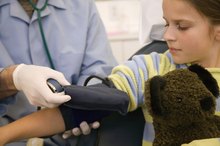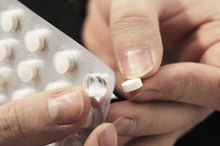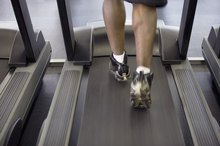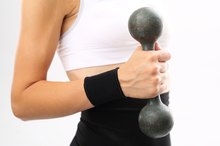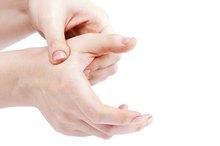Diabetics & Hand Tremors
A tremor is the most common type of involuntary movement, according to the National Institute of Neurological Disorders and Stroke 1. Your risk for hand tremors increases with age and can also be influenced by diseases you may have, including diabetes. A sudden onset of a hand tremor may be a sign that blood glucose is too low. However, chronically high blood glucose can also cause a condition known as diabetic neuropathy, which may lead to hand tremors as well.
If you are experiencing serious medical symptoms, seek emergency treatment immediately.
Types
There are three basic types of hand tremors: resting, kinetic and postural. A resting tremor occurs when your hand is at rest. A kinetic tremor happens when you are moving your hand and a postural tremor occurs when your hand is in a static position, other than resting. Many things may cause a hand tremor, but if you experience tremors regularly, contact your doctor to rule out an underlying and potentially serious disease.
- There are three basic types of hand tremors: resting, kinetic and postural.
- A resting tremor occurs when your hand is at rest.
Hypoglycemia
What Are the Causes of Hand Tremors?
Learn More
If you have diabetes and are on diabetic medications, you are at risk of becoming hypoglycemic. Experiencing shakiness, such as hand tremors, may indicate hypoglycemia. Hypoglycemia occurs when your blood sugar falls below a safe and normal level. A blood glucose below 70 mg/dl is considered hypoglycemic and should be treated immediately. Other symptoms of hypoglycemia include fatigue, confusion, hunger, sweating and dizziness.
- If you have diabetes and are on diabetic medications, you are at risk of becoming hypoglycemic.
- A blood glucose below 70 mg/dl is considered hypoglycemic and should be treated immediately.
Hypoglycemia Treatment
Chronic bouts of hypoglycemia are a cause for a visit to the doctor. Your medication may not be reflective of your lifestyle, including eating and physical activity, which can cause an unsafe reduction in blood glucose. For acute treatment of hypoglycemia, eat a carbohydrate-rich snack, such as 4 oz. of fruit juice or soda, 1 tbsp. of honey or five or six pieces of hard candy. Wait 15 minutes and re-test your blood sugar. Continue with this cycle until your glucose levels increase above 70 mg/dl.
- Chronic bouts of hypoglycemia are a cause for a visit to the doctor.
- For acute treatment of hypoglycemia, eat a carbohydrate-rich snack, such as 4 oz.
Diabetic Neuropathy
What Are Glucose Tablets Used For?
Learn More
Diabetic neuropathy may occur as a result of chronically high blood sugar, or hyperglycemia. Diabetic neuropathy is characterized as a degeneration of nerve fibers from a reduction in blood flow and high blood glucose. Hand tremors may be a symptom of diabetic neuropathy, indicating a problem with the nervous system. The trauma-affected nerves can cause the involuntary movements of a hand tremor. Keeping your blood glucose under control and in a safe range can reduce the risk of developing neuropathy.
- Diabetic neuropathy may occur as a result of chronically high blood sugar, or hyperglycemia.
- Hand tremors may be a symptom of diabetic neuropathy, indicating a problem with the nervous system.
Related Articles
References
- National Institute of Neurological Disorders and Stroke; Tremor Fact Sheet; June 2011
- HealthCentral.com; Hand Tremor; Daniel B. Hoch, Ph.D., M.D.; June 2009
- Louis ED, Wendt KJ, Pullman SL, Ford B. Is essential tremor symmetric? Observational data from a community-based study of essential tremor. Arch Neurol. 1998;55(12):1553-9. doi:10.1001/archneur.55.12.1553
- Ahmed A, Sweeney P. Cleveland Clinic Center for Continuing Education. Tremors. Updated May 2017.
- National Institute of Neurological Disorders and Stroke. Tremor fact sheet. Updated August 13, 2019.
- Smaga S. Tremor. Am Fam Physician. 2003;68(8):1545-1552.
- Basu I, Graupe D, Tuninetti D, et al. Pathological tremor prediction using surface electromyogram and acceleration: potential use in 'ON-OFF' demand driven deep brain stimulator design. J Neural Eng. 2013;10(3):036019. doi:10.1088/1741-2560/10/3/036019
- Aum DJ, Tierney TS. Deep brain stimulation: foundations and future trends. Front Biosci (Landmark Ed). 2018;23:162-182.
- Braunwald E, Fauci ES, et al. Harrison's Principles of Internal Medicine. 16th ed.
- Ropper AH, Samuels MA. Adams and Victor's Principles of Neurology, 9th ed: The McGraw-Hill Companies, Inc., 2009.
Writer Bio
Laura Niedziocha began her writing career in 2007. She has contributed material to the Stoneking Physical Therapy and Wellness Center in Lambertville, N.J., and her work has appeared in various online publications. Niedziocha graduated from Temple University with a Bachelor of Science in exercise science. She also has her Associate of Arts in communications from the Community College of Philadelphia.

